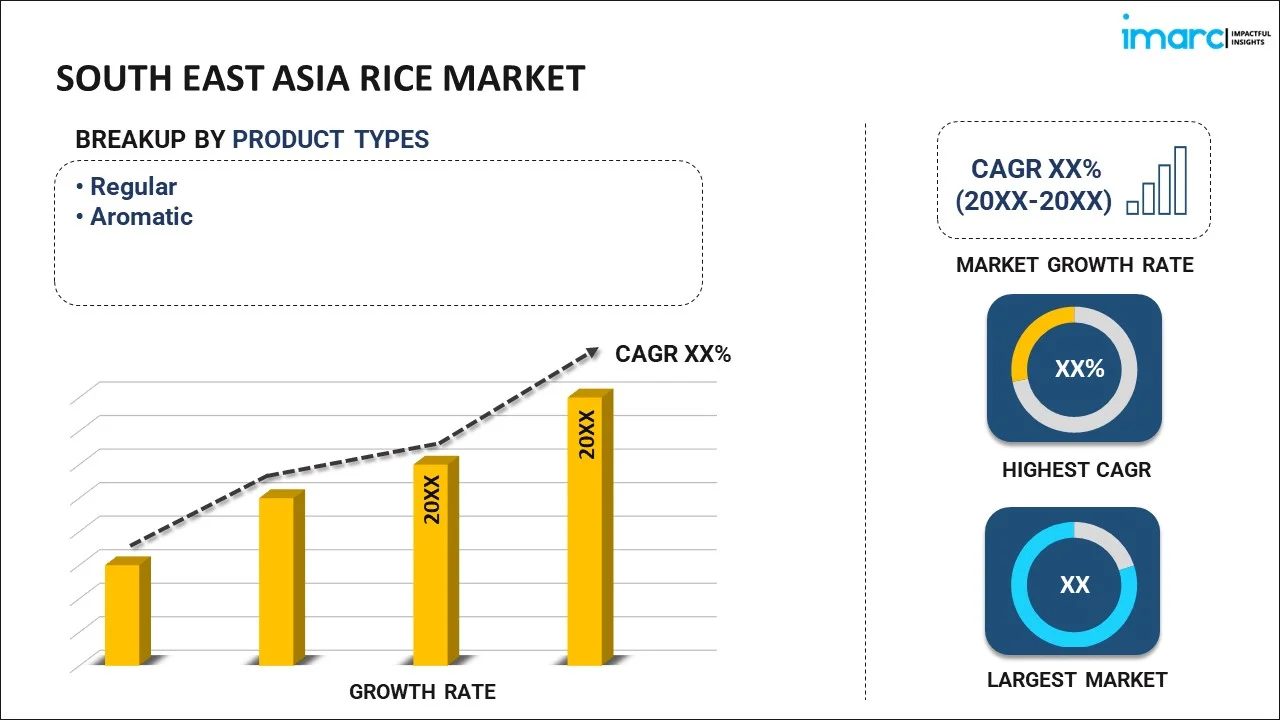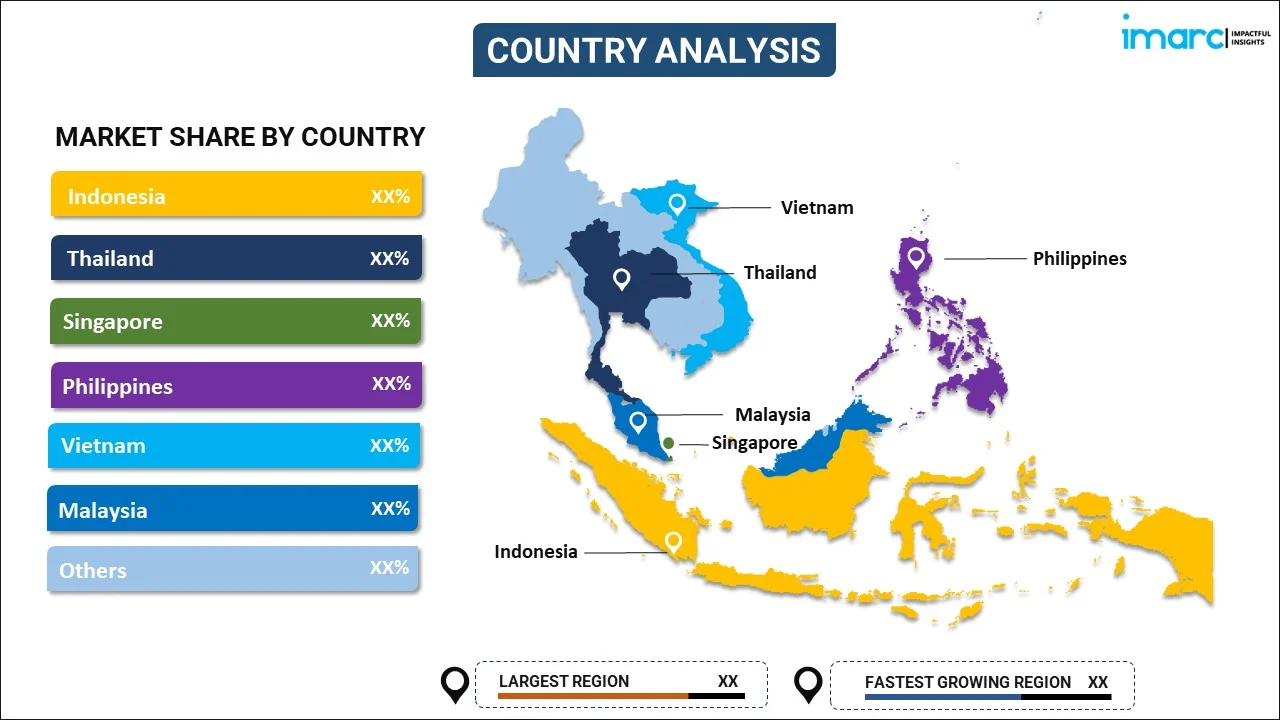
South East Asia Rice Market Report by Product Type (Regular, Aromatic), Type (Red Rice, Arborio Rice, Black Rice, Grain Fragrance Rice, Brown Rice, Rosematta Rice, Grain Parboiled Rice, Sushi Rice, and Others), Grain Size (Long Grain, Medium Grain, Short Grain), Distribution Channel (Offline Stores, Online Stores), Application (Food, Feed, and Others), and Country 2024-2032
Market Overview:
South East Asia rice market size is projected to exhibit a growth rate (CAGR) of 7.08% during 2024-2032. The increasing prevalence of changing consumer preferences, including a shift towards healthier diets and a preference for convenience, that can impact the demand for different types of rice products, is driving the market.
|
Report Attribute
|
Key Statistics
|
|---|---|
|
Base Year
|
2023 |
|
Forecast Years
|
2024-2032 |
|
Historical Years
|
2018-2023
|
| Market Growth Rate (2024-2032) | 7.08% |
Rice is one of the most vital staple foods, with a rich history spanning thousands of years. This versatile grain serves as a primary source of sustenance for a huge population, playing a significant role in various cultural, religious, and culinary traditions. With numerous varieties, including long-grain, medium-grain, and short-grain, rice offers diverse culinary possibilities, from savory dishes to sweet delicacies. Its cultivation often requires specific environmental conditions, such as flooded rice paddies for some varieties, reflecting the intricacies of traditional farming techniques. Moreover, advancements in agricultural technology have further enhanced rice production, enabling it to sustain growing populations and alleviate food scarcity in many regions. Nonetheless, rice remains more than just a dietary staple, embodying cultural significance and symbolizing unity and prosperity in many societies.
South East Asia Rice Market Trends:
The rice market in South East Asia is subject to various drivers, which significantly influence its dynamics. Firstly, in light of the ever-increasing regional population, the demand for rice remains consistently high. Furthermore, changing dietary preferences, particularly the growing preference for healthier food options, have contributed to an augmented demand for rice as a staple food across diverse cultures. In addition to this, the shift towards convenience foods and ready-to-eat meals has led to an increased demand for processed rice products, thereby impacting the overall market trajectory. Moreover, the influence of government policies and subsidies is another key factor shaping the rice market. Additionally, the fluctuations in weather patterns and the resultant impact on rice cultivation have a profound effect on supply and pricing dynamics, thereby exerting pressure on market stability. Meanwhile, technological advancements in rice production, including the development of high-yielding and disease-resistant varieties, have played a pivotal role in driving market growth and ensuring sustainable production levels. Consequently, the interplay of these multifaceted drivers underscores the complexity and resilience of the rice market in South East Asia, dictating its direction and prospects in the agricultural landscape.
South East Asia Rice Market Segmentation:
IMARC Group provides an analysis of the key trends in each segment of the market, along with forecasts at the regional and country levels for 2024-2032. Our report has categorized the market based on product type, type, grain size, distribution channel, and application.
Product Type Insights:

- Regular
- Aromatic
The report has provided a detailed breakup and analysis of the market based on the product type. This includes regular and aromatic.
Type Insights:
- Red Rice
- Arborio Rice
- Black Rice
- Grain Fragrance Rice
- Brown Rice
- Rosematta Rice
- Grain Parboiled Rice
- Sushi Rice
- Others
A detailed breakup and analysis of the market based on the type have also been provided in the report. This includes red rice, arborio rice, black rice, grain fragrance rice, brown rice, rosematta rice, grain parboiled rice, sushi rice, and others.
Grain Size Insights:
- Long Grain
- Medium Grain
- Short Grain
The report has provided a detailed breakup and analysis of the market based on the grain size. This includes long grain, medium grain, and short grain.
Distribution Channel Insights:
- Offline Stores
- Online Stores
A detailed breakup and analysis of the market based on the Distribution Channel have also been provided in the report. This includes offline stores and online stores.
Application Insights:
- Food
- Feed
- Others
The report has provided a detailed breakup and analysis of the market based on the application. This includes food, feed, and others.
Country Insights:

- Indonesia
- Thailand
- Singapore
- Philippines
- Vietnam
- Malaysia
- Others
The report has also provided a comprehensive analysis of all the major regional markets, which include Indonesia, Thailand, Singapore, Philippines, Vietnam, Malaysia, and Others.
Competitive Landscape:
The market research report has also provided a comprehensive analysis of the competitive landscape in the market. Competitive analysis such as market structure, key player positioning, top winning strategies, competitive dashboard, and company evaluation quadrant has been covered in the report. Also, detailed profiles of all major companies have been provided.
South East Asia Rice Market Report Coverage:
| Report Features | Details |
|---|---|
| Base Year of the Analysis | 2023 |
| Historical Period | 2018-2023 |
| Forecast Period | 2024-2032 |
| Units | US$ Billion |
| Scope of the Report | Exploration of Historical Trends and Market Outlook, Industry Catalysts and Challenges, Segment-Wise Historical and Future Market Assessment:
|
| Product Types Covered | Regular, Aromatic |
| Types Covered | Red Rice, Arborio Rice, Black Rice, Grain Fragrance Rice, Brown Rice, Rosematta Rice, Grain Parboiled Rice, Sushi Rice, Others |
| Grain Sizes Covered | Long Grain, Medium Grain, Short Grain |
| Distribution Channels Covered | Offline Stores, Online Stores |
| Applications Covered | Food, Feed, Others |
| Countries Covered | Indonesia, Thailand, Singapore, Philippines, Vietnam, Malaysia, Others |
| Customization Scope | 10% Free Customization |
| Report Price and Purchase Option | Single User License: US$ 3699 Five User License: US$ 4699 Corporate License: US$ 5699 |
| Post-Sale Analyst Support | 10-12 Weeks |
| Delivery Format | PDF and Excel through Email (We can also provide the editable version of the report in PPT/Word format on special request) |
Key Questions Answered in This Report:
- How has the South East Asia rice market performed so far and how will it perform in the coming years?
- What has the impact of COVID-19 on the South East Asia rice market?
- What is the breakup of the South East Asia rice market on the basis of product type?
- What is the breakup of the South East Asia rice market on the basis of type?
- What is the breakup of the South East Asia rice market on the basis of grain size?
- What is the breakup of the South East Asia rice market on the basis of distribution channel?
- What is the breakup of the South East Asia rice market on the basis of application?
- What are the various stages in the value chain of the South East Asia rice market?
- What are the key driving factors and challenges in South East Asia rice?
- What is the structure of the South East Asia rice market and who are the key players?
- What is the degree of competition in the South East Asia rice market?
Key Benefits for Stakeholders:
- IMARC’s industry report offers a comprehensive quantitative analysis of various market segments, historical and current market trends, market forecasts, and dynamics of the South East Asia rice market from 2018-2032.
- This research report provides the latest information on the market drivers, challenges, and opportunities in the South East Asia rice market.
- Porter's five forces analysis assist stakeholders in assessing the impact of new entrants, competitive rivalry, supplier power, buyer power, and the threat of substitution. It helps stakeholders to analyze the level of competition within the South East Asia rice industry and its attractiveness.
- A competitive landscape allows stakeholders to understand their competitive environment and provides an insight into the current positions of key players in the market.
Need more help?
- Speak to our experienced analysts for insights on the current market scenarios.
- Include additional segments and countries to customize the report as per your requirement.
- Gain an unparalleled competitive advantage in your domain by understanding how to utilize the report and positively impacting your operations and revenue.
- For further assistance, please connect with our analysts.
 Inquire Before Buying
Inquire Before Buying
 Speak to an Analyst
Speak to an Analyst
 Request Brochure
Request Brochure
 Request Customization
Request Customization




.webp)




.webp)












